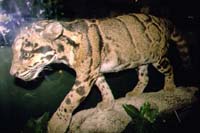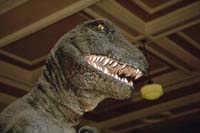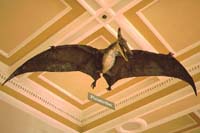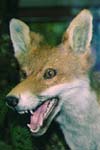
|
Natural History is the main subject of the Science Department at the Art Gallery and Museum. The collection reflects the three main areas of Natural History: geology, botany and zoology. The total number of objects in the Natural History collection is vast, ranging in size from microscopic specimens on slides to huge skeletons. The collection dates back to the original Kelvingrove Museum in the 1870s. During the early part of the twentieth century, the entire collection was displayed in the new Art Gallery and Museum. In present times this is not possible, as the collection has grown so much. Presentation style has also changed, with themed displays now being more popular. |
|
As well as the items on display, the Natural History collection includes many specimens preserved for future scientific research. Some of these items are over two hundred years old, and are still in good condition as a result of good preservation techniques and careful storage. |
 |
Clouded Leopard |
DISPLAY TECHNIQUES
 |
The wide variety of specimens in the Natural History collection requires an equally wide range of display and preservation techniques. Taxidermy is used for animals and birds. This involves preserving the skins and displaying them in a life-like pose. Taxidermy is a highly skilled traditional technique which combines detailed knowledge of the appearance and behaviour of the animals in their natural environment with artistic and technical skills. Dry preservation is used is for plants, small animals and invertebrates. Freeze-drying is a modern development, where the internal and external structure of the specimen is preserved. It works by reducing the temperature and pressure of the specimen until all the water vapour is removed, leaving the cellular structure intact. Wet preservation is used for soft-bodied animals such as molluscs, and insects. This technique involves storing the specimen in a preservative solution. In the 19th century, Jamaican rum and Geneva gin were used as preservative solutions. Nowadays, industrial methylated spirits are used. Fossils and other geological specimens also require treatment. Any unwanted material surrounding the specimen must be carefully chipped away. This is followed by chemical treatment. Modelling is an important display technique. Casts in
resins, foam and rubber are made from original specimens. Examples
of this technique are frogs, fish, slugs and sea anemones. Modelling
techniques are used extensively for display case backgrounds. |
|
COLLECTING
|
Most of the specimens in the Natural History collection are obtained by donation. Members of the public who make interesting finds very often donate the items to the Museum. Naturalists who acquire collections often bequeath them to museums. The Museum has also purchased items on the open market. Field work is an important method of adding to the Museum's
collection. This involves the staff going out and collecting material
from a variety of locations. |
 |
Tyrannoraurus
|
|
Pteranodon |
 |
Field work requires careful planning, as some species of plants and animals can only be found at certain times of the year. Many interesting finds are also unearthed at civil engineering works. Local sites have yielded many interesting marine specimens, and
one of the earliest collections donated to the Museum was that
of David Robertson (1806-1896). He founded the Marine Biological
Association at Millport. |
CONSERVATION
|
The Natural History section has an important part to play in convservation. Displaying rare species can help to reduce the pressure on remote or fragile environments. It can also reduce the pressure on the species themselves. Conservation has become an important issue in recent years. Present-day
natural historians are much less concerned with the widespread
collection of plants and animals than their predecessors. Instead,
they seek to preserve species and protect the environment. |
 |
Ichthyosaur "Fish Lizard" |
|
White-Tailed Sea Eagle
|
 |
The Natural History department has a legal duty when acquiring specimens for its collection. It must follow the many regulations covering nature reserves and sites of special scientific interest. Licences are required for collecting certain rare species, and
permission must be sought from landowners before any plants can
be uprooted. Some species are prohibited by law from being disturbed
or even photographed. |


